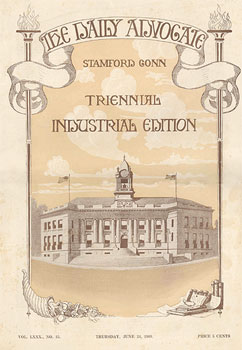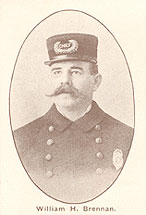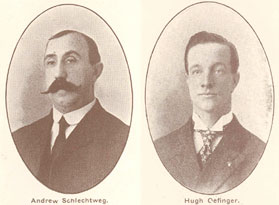The
Stamford Historical Society Presents
Law & Order: The
History of the Stamford Police Department 1830-1956
a 2004 Exhibit and more
 The
Daily Advocate of Stamford Connecticut
The
Daily Advocate of Stamford Connecticut
Triennial
Industrial Edition
Vol.
LXXX., NO. 45.
Thursday,
June 24, 1909
Stamford Police Department
The Police Department of Stamford compares favorably with that of any city
of its size in the land. Including the Chief of Police, William H. Brennan,
it numbers 20 men. There are two sergeants, William F. Nevins and Walter P.
Williams, a detective (soon to be detective sergeant) James J. Heffernan, an
acting detective and dog warden, Thomas Foley, the driver of the patrol wagon
and ambulance. Dennis Reardon, and a working force of fourteen patrolmen. Aside
from these regular members of the department there are 30 special policemen
who may be called upon for duty at any time.
The police department is housed in the Town Hall and it takes up more of the
Town Building than any other one city department. There are separate departments
for male and female prisoners, each equipped with the most sanitary plumbing
and appliances, a padded cell of the best type, a roomy locker and lounging
room for the patrolmen, a dormitory with modern plumbing. The Chief of Police
has a private office on the first floor of the building in which are kept the
records and relics. A card index system in use here facilitates searching of
the records. Half a story above is the detective bureau with rogues' gallery
and complete records which are kept by Detective Heffernan. The Sergeants'
office is on the ground floor with entrance upon Bank Street.
The equipment includes a police telephone system. There are 17 boxes in this
system and officers are required to call headquarters from them, while on duty,
at stated periods. The ambulance and patrol wagon are practically new and are
in excellent condition. An inventory of the department would include the fine
police horse which has taken a new lease of life under the careful handling
of Driver Reardon.

The patrolmen work in three shifts of eight hours each. The sergeants work
11 hours per day and the Chief, detectives and driver are on duty practically
all the time. The patrolmen are about to be equipped with a uniform firearm.
It is about the only thing they now lack. There is a police pension system
by which an officer who has served 20 years or is disabled in the performance
of his duty may be retired on half pay.
 William H. Brennan
is the second chief of police of Stamford. He succeeded George Bowman, who died
September 14, 1903. He was made acting chief August 11, 1903 and was appointed
by mayor Homer S. Cummings on August 14, 1905 , after Mayor Charles H. Leeds
had, on March 14, 1904 attempted to make the appointment and failed because of
the withdrawal of members of the Common Council. Previously Chief Brennan had
been a patrolman, having entered the department
February 14, 1893 . Chief Brennan is a native of Stamford. He is 44 years old,
is 5 feet 111/2 inches tall and weighs 243 pounds. He was a member of the first
Common Council of the City of Stamford , having been elected from the Second
Ward.
William H. Brennan
is the second chief of police of Stamford. He succeeded George Bowman, who died
September 14, 1903. He was made acting chief August 11, 1903 and was appointed
by mayor Homer S. Cummings on August 14, 1905 , after Mayor Charles H. Leeds
had, on March 14, 1904 attempted to make the appointment and failed because of
the withdrawal of members of the Common Council. Previously Chief Brennan had
been a patrolman, having entered the department
February 14, 1893 . Chief Brennan is a native of Stamford. He is 44 years old,
is 5 feet 111/2 inches tall and weighs 243 pounds. He was a member of the first
Common Council of the City of Stamford , having been elected from the Second
Ward.
The police force has been steadily increasing in efficiency, since it was
established under the present system, and its organization at present
seems to meet all requirements, although, as the city's population increases,
it will necessarily be enlarged. The officers and members of the force
are intelligent and courteous, and in a variety of ways perform for the people
many useful services besides the one for which they are primarily engaged,
the protection of life and property.
The proximity of Stamford to the largest city on the continent, and the fact
that the population of this town includes people of almost every race, serve
to emphasize the need of a good police force, and on many notable occasions
it has shown its ability to meet any emergency which might arise.
 In addition to the uniformed force of the city, the town constables perform
useful service, not only in the apprehension of persons who violate the
law, but in the service of civil process, and occasionally in the
performance of detective duty. Of the constables, those who are most active,
and who are usually regarded as most efficient are Andrew Schlechtweg and
Hugh Oefinger, both of whom have had much experience in all the branches
of work that a constable is expected to do, and who have done excellent
service on numerous occasions as peace officers.
In addition to the uniformed force of the city, the town constables perform
useful service, not only in the apprehension of persons who violate the
law, but in the service of civil process, and occasionally in the
performance of detective duty. Of the constables, those who are most active,
and who are usually regarded as most efficient are Andrew Schlechtweg and
Hugh Oefinger, both of whom have had much experience in all the branches
of work that a constable is expected to do, and who have done excellent
service on numerous occasions as peace officers.
While the city policemen are appointed for an indefinite term, and are removable
only for cause, the town constables are elected for a term of two years. When,
however, the people find a man performing good service as a constable, there
is little danger that he will fail of endorsement at the polls, and a town
constable who is efficient and faithful can usually remain in office as long
as he desires.
A Federal Building to cost $150,000, exclusive of the site, is one of the
new things Stamford expects to see in 1910.


 The
Daily Advocate of Stamford Connecticut
The
Daily Advocate of Stamford Connecticut
 William H. Brennan
is the second chief of police of Stamford. He succeeded George Bowman, who died
September 14, 1903. He was made acting chief August 11, 1903 and was appointed
by mayor Homer S. Cummings on August 14, 1905 , after Mayor Charles H. Leeds
had, on March 14, 1904 attempted to make the appointment and failed because of
the withdrawal of members of the Common Council. Previously Chief Brennan had
been a patrolman, having entered the department
February 14, 1893 . Chief Brennan is a native of Stamford. He is 44 years old,
is 5 feet 111/2 inches tall and weighs 243 pounds. He was a member of the first
Common Council of the City of Stamford , having been elected from the Second
Ward.
William H. Brennan
is the second chief of police of Stamford. He succeeded George Bowman, who died
September 14, 1903. He was made acting chief August 11, 1903 and was appointed
by mayor Homer S. Cummings on August 14, 1905 , after Mayor Charles H. Leeds
had, on March 14, 1904 attempted to make the appointment and failed because of
the withdrawal of members of the Common Council. Previously Chief Brennan had
been a patrolman, having entered the department
February 14, 1893 . Chief Brennan is a native of Stamford. He is 44 years old,
is 5 feet 111/2 inches tall and weighs 243 pounds. He was a member of the first
Common Council of the City of Stamford , having been elected from the Second
Ward.
 In addition to the uniformed force of the city, the town constables perform
useful service, not only in the apprehension of persons who violate the
law, but in the service of civil process, and occasionally in the
performance of detective duty. Of the constables, those who are most active,
and who are usually regarded as most efficient are Andrew Schlechtweg and
Hugh Oefinger, both of whom have had much experience in all the branches
of work that a constable is expected to do, and who have done excellent
service on numerous occasions as peace officers.
In addition to the uniformed force of the city, the town constables perform
useful service, not only in the apprehension of persons who violate the
law, but in the service of civil process, and occasionally in the
performance of detective duty. Of the constables, those who are most active,
and who are usually regarded as most efficient are Andrew Schlechtweg and
Hugh Oefinger, both of whom have had much experience in all the branches
of work that a constable is expected to do, and who have done excellent
service on numerous occasions as peace officers.